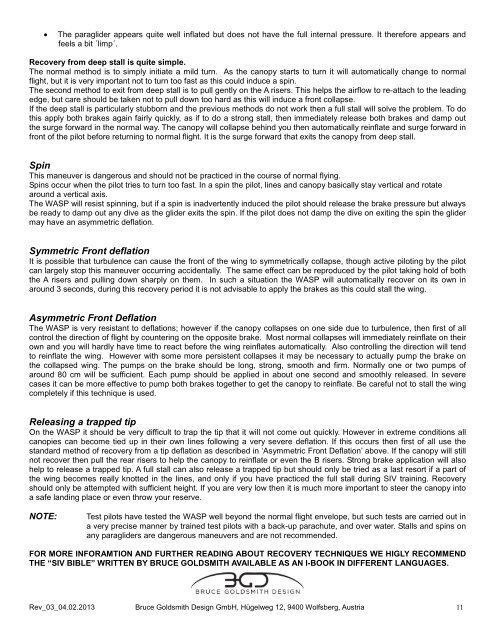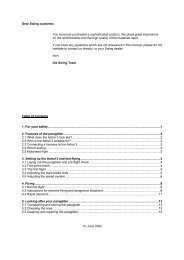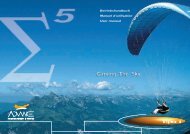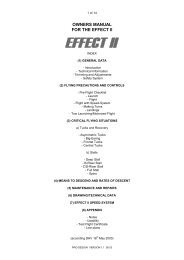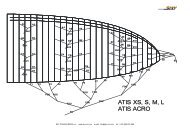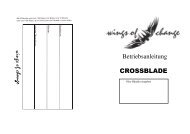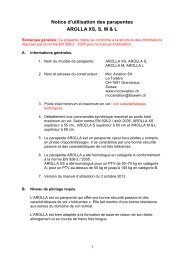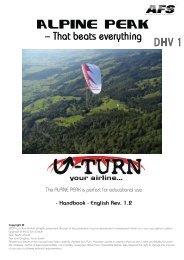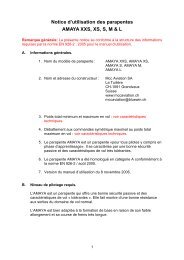Wasp - Manuel d'utilisation - Bruce Goldsmith Design
Wasp - Manuel d'utilisation - Bruce Goldsmith Design
Wasp - Manuel d'utilisation - Bruce Goldsmith Design
Sie wollen auch ein ePaper? Erhöhen Sie die Reichweite Ihrer Titel.
YUMPU macht aus Druck-PDFs automatisch weboptimierte ePaper, die Google liebt.
The paraglider appears quite well inflated but does not have the full internal pressure. It therefore appears and<br />
feels a bit ´limp´.<br />
Recovery from deep stall is quite simple.<br />
The normal method is to simply initiate a mild turn. As the canopy starts to turn it will automatically change to normal<br />
flight, but it is very important not to turn too fast as this could induce a spin.<br />
The second method to exit from deep stall is to pull gently on the A risers. This helps the airflow to re-attach to the leading<br />
edge, but care should be taken not to pull down too hard as this will induce a front collapse.<br />
If the deep stall is particularly stubborn and the previous methods do not work then a full stall will solve the problem. To do<br />
this apply both brakes again fairly quickly, as if to do a strong stall, then immediately release both brakes and damp out<br />
the surge forward in the normal way. The canopy will collapse behind you then automatically reinflate and surge forward in<br />
front of the pilot before returning to normal flight. It is the surge forward that exits the canopy from deep stall.<br />
Spin<br />
This maneuver is dangerous and should not be practiced in the course of normal flying.<br />
Spins occur when the pilot tries to turn too fast. In a spin the pilot, lines and canopy basically stay vertical and rotate<br />
around a vertical axis.<br />
The WASP will resist spinning, but if a spin is inadvertently induced the pilot should release the brake pressure but always<br />
be ready to damp out any dive as the glider exits the spin. If the pilot does not damp the dive on exiting the spin the glider<br />
may have an asymmetric deflation.<br />
Symmetric Front deflation<br />
It is possible that turbulence can cause the front of the wing to symmetrically collapse, though active piloting by the pilot<br />
can largely stop this maneuver occurring accidentally. The same effect can be reproduced by the pilot taking hold of both<br />
the A risers and pulling down sharply on them. In such a situation the WASP will automatically recover on its own in<br />
around 3 seconds, during this recovery period it is not advisable to apply the brakes as this could stall the wing.<br />
Asymmetric Front Deflation<br />
The WASP is very resistant to deflations; however if the canopy collapses on one side due to turbulence, then first of all<br />
control the direction of flight by countering on the opposite brake. Most normal collapses will immediately reinflate on their<br />
own and you will hardly have time to react before the wing reinflates automatically. Also controlling the direction will tend<br />
to reinflate the wing. However with some more persistent collapses it may be necessary to actually pump the brake on<br />
the collapsed wing. The pumps on the brake should be long, strong, smooth and firm. Normally one or two pumps of<br />
around 80 cm will be sufficient. Each pump should be applied in about one second and smoothly released. In severe<br />
cases it can be more effective to pump both brakes together to get the canopy to reinflate. Be careful not to stall the wing<br />
completely if this technique is used.<br />
Releasing a trapped tip<br />
On the WASP it should be very difficult to trap the tip that it will not come out quickly. However in extreme conditions all<br />
canopies can become tied up in their own lines following a very severe deflation. If this occurs then first of all use the<br />
standard method of recovery from a tip deflation as described in ‘Asymmetric Front Deflation’ above. If the canopy will still<br />
not recover then pull the rear risers to help the canopy to reinflate or even the B risers. Strong brake application will also<br />
help to release a trapped tip. A full stall can also release a trapped tip but should only be tried as a last resort if a part of<br />
the wing becomes really knotted in the lines, and only if you have practiced the full stall during SIV training. Recovery<br />
should only be attempted with sufficient height. If you are very low then it is much more important to steer the canopy into<br />
a safe landing place or even throw your reserve.<br />
NOTE:<br />
Test pilots have tested the WASP well beyond the normal flight envelope, but such tests are carried out in<br />
a very precise manner by trained test pilots with a back-up parachute, and over water. Stalls and spins on<br />
any paragliders are dangerous maneuvers and are not recommended.<br />
FOR MORE INFORAMTION AND FURTHER READING ABOUT RECOVERY TECHNIQUES WE HIGLY RECOMMEND<br />
THE “SIV BIBLE” WRITTEN BY BRUCE GOLDSMITH AVAILABLE AS AN I-BOOK IN DIFFERENT LANGUAGES.<br />
Rev_03_04.02.2013 <strong>Bruce</strong> <strong>Goldsmith</strong> <strong>Design</strong> GmbH, Hügelweg 12, 9400 Wolfsberg, Austria 11


